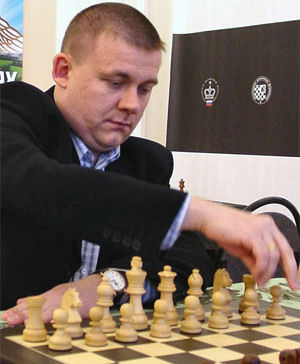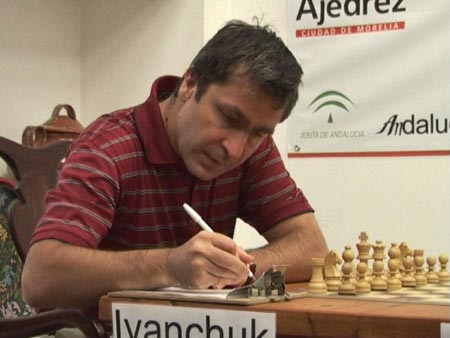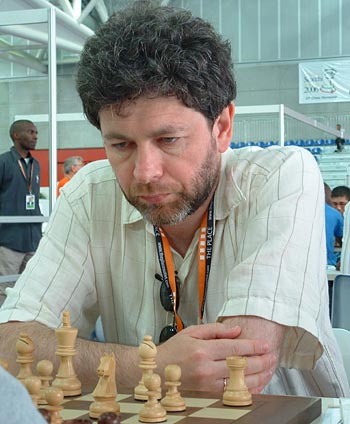| Latest | Greatest | Lobby | Journals | Search | Options | Help | Login |
|
|
|
This topic is archived. |
| Home » Discuss » Topic Forums » Sports |
|
| Jack Rabbit
|
Mon Apr-14-08 07:15 PM Original message |
| Jack Rabbit Chess Report (April 14): Ekaterininburg take Russian Team Championship |
|
Edited on Mon Apr-14-08 07:37 PM by Jack Rabbit
Ekaterininburg victorious in Russian Team Championships
 Northern Ural of Ekaterinaburg, led by Azerbaijani star Teimour Radjabov and Latvian/Spanish grandmaster Alexei Shirov, won the Russian team championships in Sochi on Sunday. Ekaterininburg led the tournament wire to wire, finishing with 17 points, 2 points ahead of Economist-1 of Saratov and three ahead of TPS-Saransk. The defending champions, Tomsk 400, got off to a slow start and never recovered. Tomsk finished with 10 points out of a possible 22, good for ninth place out of twelve teams. Smeets, Peng win Dutch National Championships  Jan Smeets defeated Daniel Stellwagen in a dramatic last round showdown to win the overall Dutch national title in Hilversum Sunday. Stellwagen had led the event most of the way and entered the final round with 7 points out of ten, a half point ahead of Smeets. Stellwagen, who was also the runner-up last year, needed only a draw to secure the title. Smeets, playing White, opened with his King's pawn which Stellwagen met with a variation of the Open Sicilian known as the Taimanov Defense. The game was equal through 30 moves when Smeets sacrificed a pawn, which he soon recovered giving him two connected passed pawns on the queenside. Stellwagen maneuvered to gain a connected pair of passers on the opposite wing, but Smeets' a-pawn was further advanced than either of Stellwagen's. On the 45th move when Black had no way to prevent White from getting his Rook behind the passed a-pawn, by then on the sixth rank, Stellwagen resigned. Granmaster Dimitri Reinderman won his last round game and tied Stellwagen for second place. In the ladies' championship, grandmaster and Chinese native Peng Zhaoqin won her ninth consecutive national title and tenth overall since settling in Holland in 1996. Mw. Peng scored 8 points in nine rounds to finish a point and a half ahead her nearest rival, Petra Schuurman. Tea Lanchava, another immigrant who originally hails from Georgia, finished third with 5½ points. 14-year-old GM takes Dubai Open  Wesley So of the Philippines, who is currently the world's youngest grandmaster at the age of 14, won the Dubai Open, the most presigious chess evnet held annually in Arab nation, with 7 points out of nine rounds Monday. Young Mr. So was awarded the tournament championship based on his superior tie-break score over Georgia's Merab Gagunashvili, Ghaem Maghami of Iran and Chinese grandmaster Li Chao, all of whom also scored 7 points. Wesley was awarded the grandmasters title by FIDE in December. He took over the distinction of being the world's youngest GM from Parimarjan Negi of India, who became a grandmaster at 13 and is now 15. Adams places first in Mérdia  British grandmaster Mickey Adams won the second annual Ruy Lopez Chess Festival in Mérdia, Spain, an imperial Roman city that was the birthplace of the sixteenth-century friar and chess master. Adams scored 5½ points in seven rounds, winning four game without a loss. Grandmaster Zhang Pengxiang pf China finished second with 5 points and the defending champion, Armenia's Gabriel Sargissian, tied for third with Koneru Humpy of India, who is the world's second-ranked woman player. Gausdal Classic concludes Wednesday  The annual international tournament in Gausdal, Norway, began last Tuesday and will conclude after nine rounds this coming Wednesday. American grandmaster Gregory Kaidanov is leading with 5½ points after seven rounds, a full point over Norwegian GM Kjetil Lie and two Indian grandmasters, Chandra Sandeepan and Geetha Naraynan Gopal. Another American, reigning US women's champion Irina Krush, was attempting to score a grandmaster norm in the event, but currently has only 2½ points and will fall short. |
| Printer Friendly | Permalink | | Top |
| Jack Rabbit
|
Mon Apr-14-08 07:16 PM Response to Original message |
| 1. Games From the Russian Team Championships, Sochi |
|
Diagrams on the Jack Rabbit Chess Report are made with Chess Mérida, a true type font that can be downlaoded free here. !""""""""# $tMvWlVmT% $OoOoOoOo% $ + + + +% $+ + + + % $ + + + +% $+ + + + % $pPpPpPpP% $RnBqKbNr% /(((((((() WHITE White to move (This position is a theoretical draw) |
| Printer Friendly | Permalink | | Top |
| Jack Rabbit
|
Mon Apr-14-08 07:20 PM Response to Reply #1 |
| 4. Rublevsky - Zwjaginsev, Moscow-64 vs. St. Petersburg FINEK, Round 5 |
 Sergei Rublevsky Sergei Rublevsky (Moscow-64) - Vadim Zvjaginsev (St. Petersburg) Russian Team Championship. Round 5 Sochi, 6 April 2008 Open Sicilian Game: Dragon Defense 1.e4 c5 2.Nf3 d6 3.d4 cxd4 4.Nxd4 Nf6 5.Nc3 g6 6.Be2
6...Bg7 7.0-0 0-0 8.Re1
8...Nc6 9.Nb3 Nd7!?
10.Bg5
10...Nc5
11.Nxc5 dxc5 12.Nd5!?
12...Bxb2 13.Rb1 Bg7
14.Bc4 a6?!
15.Rb6!
15...Kh8
!""""""""# $t+vW T L% $+o+ OoVo% $oRn+ +o+% $+ On+ B % $ +b+p+ +% $+ + + + % $p+p+ PpP% $+ +qR K % /(((((((() WHITE: Sergei Rublevsky Position after 15...Kg8h8 16.Rxc6!!
16...bxc6 17.Bxe7!
17...Qa5 18.Bxf8 Bxf8 19.Ne3
19...Ra7 20.Qe2 Re7 21.Rb1 Bg7
22.Qd3 Rd7??
!""""""""# $ +v+ + L% $+ +t+oVo% $o+o+ +o+% $W O + + % $ +b+p+ +% $+ +qN + % $p+p+ PpP% $+r+ + K % /(((((((() WHITE: Sergei Rublevsky Position after 22...Re7d7 23.Qxd7!! 1-0
|
| Printer Friendly | Permalink | | Top |
| Herman74
|
Tue Apr-15-08 07:53 PM Response to Reply #4 |
| 10. What's up with the a-pawn & Grandmaster Rublevsky? |
|
Edited on Tue Apr-15-08 07:57 PM by Herman74
It appears as though Grandmaster Rublevsky is reaching for the a-pawn for the first move of the game!:o
(I suppose that someone will reply that Grandmaster Rublevsky had just finished placing the pawn on a2 for the game's commencement, but I like my initial speculation). |
| Printer Friendly | Permalink | | Top |
| Jack Rabbit
|
Wed Apr-16-08 11:24 AM Response to Reply #10 |
| 11. Rublevsky is known to be a speculative player |
|
His motto is I just sit down a play chess.
Searching databases, I am unable to find any instance of Rublevsky playing Anderssen's Opening (1.a3) as White. He has added quite a bit of useful theory to the Scotch Opening and the Spanish Sicilian (1.e4 c5 2.Nf3 Nc6 (or 2...d6) 3.Bb4). |
| Printer Friendly | Permalink | | Top |
| Jack Rabbit
|
Mon Apr-14-08 07:22 PM Response to Reply #1 |
| 5. Morozevich - Ivanchuk, Tomsk-400 vs. TPS-Saransk, Round 7 |
 Vassily Ivanchuk Alexander Morozevich (Tomsk) - Vassily Ivanchuk (Saransk) Russian Team Championships, Round 7 Sochi, 9 April 2008 Open Sicilian Game: Dragon Defense 1.e4 c5 2.Nf3 Nc6 3.d4 cxd4 4.Nxd4 g6 5.Be2
5...Bg7 6.Nb3 d6 7.0-0 Nf6 8.Nc3 0-0 9.Bg5
9...Be6
10.f4
10...b5 11.a3!?
11...a5
12.Bf3 a4 13.Nc1 Nd7 14.Nd3
14...Nc5 15.Kh1?!
15...Nxd3
16.cxd3 Rb8
17.f5
17...Bb3 18.Qd2 b4
19.axb4 Rxb4 20.Bh6 Qb6 21.Bxg7?
21...Kxg7 22.Bd1 Bxd1 23.Qxd1 !""""""""# $ + + T +% $+ + OoLo% $ WmO +o+% $+ + +p+ % $pT +p+ +% $+ Np+ + % $ P + +pP% $R +q+r+k% /(((((((() WHITE: Alexander Morozevich Position after 23.Qd2d1:B 23...Qd4!
24.Nd5
24...Rb3 25.Qc1
25...Ne5 26.Qc7
26...Nxd3 27.Qxe7 Nf2+ 28.Rxf2
28...Qxf2 29.Qxd6
!""""""""# $ + + T +% $+ + +oLo% $ + Q +o+% $+ +n+p+ % $o+ +p+ +% $+t+ + + % $ P + WpP% $R + + +k% /(((((((() WHITE: Alexander Morozevich Position after 29.Qe7d6:p 29...Rc8!
30.f6+ Kh6 31.Qd7 Rxb2!
32.Qg4 Rcc2 33.Nf4
33...a3 34.h4 Rb5
35.Rxa3 Qd4 36.Nd5 Rb1+ 37.Kh2 Qg1+ 0-1
|
| Printer Friendly | Permalink | | Top |
| Jack Rabbit
|
Mon Apr-14-08 07:17 PM Response to Original message |
| 2. Games from the Dutch National Championships, Hilversum |
|
Diagrams on the Jack Rabbit Chess Report are made with Chess Mérida, a true type font that can be downlaoded free here. !""""""""# $tMvWlVmT% $OoOoOoOo% $ + + + +% $+ + + + % $ + + + +% $+ + + + % $pPpPpPpP% $RnBqKbNr% /(((((((() WHITE White to move (This position is a theoretical draw) |
| Printer Friendly | Permalink | | Top |
| Jack Rabbit
|
Mon Apr-14-08 07:24 PM Response to Reply #2 |
| 6. Stellwagen - Janssen, Round 6 |
 Daniel Stellwagen Daniel Stellwagen - Ruud Janssen Dutch National Championships, Round 6 Hilversum, 7 April 2008 Spanish Grand Royal Game: Chigorin Defense 1.e4 e5 2.Nf3 Nc6 3.Bb5 a6 4.Ba4 Nf6 5.0-0 Be7 6.Re1 b5 7.Bb3 d6 8.c3 0-0 9.h3 Na5 10.Bc2 c5 11.d4 Qc7
12.Nbd2
12...Bd7
13.dxe5 dxe5 14.Nf1 Rad8
15.Qe2 c4!
16.Ne3
16...g6 17.b4!?
17...Nb7!?
18.a4
18...Bc6?!
!""""""""# $ + T Tl+% $+mW Vo+o% $o+ + No+% $+o+ O + % $pPo+p+ +% $+ P Nn+p% $ +b+qPp+% $R B R K % /(((((((() WHITE: Daniel Stellwagen Position after 18...Bd7c6 19.Ng4!
19...Nxg4
20.hxg4 Rd7 21.axb5!
21...Bxb5
22.Be3 Nd8?
23.Red1 Rxd1+ 24.Rxd1 Ne6 25.Rd5 f6 !""""""""# $ + + Tl+% $+ W V +o% $o+ +mOo+% $+v+rO + % $ Po+p+p+% $+ P Bn+ % $ +b+qPp+% $+ + + K % /(((((((() WHITE: Daniel Stellwagen Position after 25...f7f6 26.g5!!
26...Nxg5 27.Nxg5 fxg5 28.Qg4!
28...Bc6
29.Qe6+ Rf7 30.Qxe5 Qb7 31.Bd4 Rf6 32.Rd6 1-0
|
| Printer Friendly | Permalink | | Top |
| Jack Rabbit
|
Mon Apr-14-08 07:27 PM Response to Reply #2 |
| 7. Peng - M. Bensdorp, Round 1 |
 Peng Zhaoqin {i] Peng Zhaoqin - Marlies Bensdorp Dutch National Championships, Round 1 Hilversum, 4 April 2008 Semi-Slav Queen's Gambit: Stonewall Defense 1.d4 d5 2.c4 c6 3.Nc3 e6 4.e3 Bd6
5.a3!?
5...f5
6.g4!?
6...fxg4 7.Qxg4 Qd7
8.Nf3 Nf6 9.Qg2 Qe7 10.Ne5 Nbd7
11.f4 0-0 12.Bd2 dxc4 13.Bxc4 c5?!
14.Nb5 Bb8 15.Rg1!
!""""""""# $tVv+ Tl+% $Oo+mW Oo% $ + +oM +% $+nO N + % $ +bP P +% $P + P + % $ P B +qP% $R + K R % /(((((((() WHITE: Peng Zhaoqin Position after 15.Rh1g1 15...Nb6?
16.dxc5!
16...Nxc4 17.Nxc4 g6
18.Nbd6 Nd5
19.Qg3
19...b6 20.e4 Nf6 21.0-0-0 b5
22.Ne5 Nh5
!""""""""# $tVv+ Tl+% $O + W +o% $ + No+o+% $+oP N +m% $ + +pP +% $P + + Q % $ P B + P% $+ Kr+ R % /(((((((() WHITE: Peng Zhaoqin Position after 22...Nf6h5 23.Nxg6!!
23...hxg6 24.Qxg6+ Ng7 25.Bc3 Bxd6 26.cxd6 1-0
|
| Printer Friendly | Permalink | | Top |
| Jack Rabbit
|
Mon Apr-14-08 07:18 PM Response to Original message |
| 3. Games from other events |
|
Diagrams on the Jack Rabbit Chess Report are made with Chess Mérida, a true type font that can be downlaoded free here. !""""""""# $tMvWlVmT% $OoOoOoOo% $ + + + +% $+ + + + % $ + + + +% $+ + + + % $pPpPpPpP% $RnBqKbNr% /(((((((() WHITE White to move (This position is a theoretical draw) |
| Printer Friendly | Permalink | | Top |
| Jack Rabbit
|
Mon Apr-14-08 07:31 PM Response to Reply #3 |
| 8. Zhang Pengxizng - Sargissian, Merida, Round 3 |
 Gabriel Sargissian Zhang Pengxiang - Gabriel Sargissian Ruy Lopez Masters Tournament, Round 3 Merida, 7 April 2008 Open Royal Game: Malaniuk Opening (Scotch Opening) 1.e4 e5 2.Nf3 Nc6 3.d4 exd4 4.Nxd4 Bb4+
5.c3 Bc5 6.Be3 Bb6 7.Nxc6
7...bxc6 8.Bd4 Nf6 9.e5
9...Nd5!?
10.Bc4
10...0-0 11.Bxd5 cxd5 12.Bxb6 axb6 13.0-0
13...Re8
14.Re1 Qg5!?
15.Qd4
15...d6
16.Qxd5?!
16...Rb8 17.Qd2
17...Rxe5 18.Rxe5 Qxe5 19.Qe3
19...Be6
!""""""""# $ T + +l+% $+ O +oOo% $ O Ov+ +% $+ + W + % $ + + + +% $+ P Q + % $pP + PpP% $Rn+ + K % /(((((((() WHITE: Zhang Pengxiang Position after 19...Bc8e6 20.Qxe5?!
20...dxe5
21.Kf1 Ra8 22.a3
22...f5
23.Nd2 Kf7 24.Rc1
24...Kf6 25.c4 e4!
26.Ke2
26...Rd8 27.a4 c5 28.Rc3 Rd4 29.b3
29...f4 30.Rc1?
30...Ke5 31.a5
31...bxa5 32.Ra1
!""""""""# $ + + + +% $+ + + Oo% $ + +v+ +% $O O L + % $ +pToO +% $+p+ + + % $ + NkPpP% $R + + + % /(((((((() WHITE: Zhang Pengxiang Position after 32.Rc1a1 32...Bg4+!
33.Ke1
33...e3!
34.fxe3 fxe3 35.Nf3+ Bxf3 36.gxf3
!""""""""# $ + + + +% $+ + + Oo% $ + + + +% $P O L + % $ +pT + +% $+p+ Op+ % $ + + + P% $R + K + % /(((((((() WHITE: Zhang Pengxiang Position after 36.gf3:B 36...Rd2!
37.Rxa5 Kd4 38.Ra7 Rxh2
39.Rxg7 h5 40.Rg5 h4 41.Rd5+
41...Kc3 42.Rxc5
42...h3 43.Rh5
43...Ra2 44.c5 h2 45.c6 h1Q+ 46.Rxh1 Kd3 0-1
|
| Printer Friendly | Permalink | | Top |
| Jack Rabbit
|
Mon Apr-14-08 07:34 PM Response to Reply #3 |
| 9. So - Saleh, Dubai, Round 5 |
|
Edited on Mon Apr-14-08 07:43 PM by Jack Rabbit
 Wesley So Wesley So - Salem Saleh 10th Open Tournament, Round 5 Dubai, 10 April 2008 Open Sicialian Game: Sveshnifov Defense (Chelyabinsk Variation) 1.e4 c5 2.Nf3 Nc6 3.d4 cxd4 4.Nxd4 Nf6 5.Nc3 e5 6.Ndb5 d6 7.Bg5
7...a6 8.Na3 b5 9.Bxf6 gxf6 10.Nd5 f5 11.Bd3 Be6 12.0-0
12...Bxd5 13.exd5 Ne7 14.c3
14...e4 15.Bc2 Bg7 16.Qh5 0-0 17.Rae1 Qc8 18.Kh1 Rb8!?
19.g4
19...b4 20.cxb4 Bxb2?
21.Qg5+!?
21...Ng6
22.gxf5!
22...Bxa3 23.fxg6
23...fxg6
24.Bxe4 Qd8
25.Qg3!
25...Bxb4
!""""""""# $ T W Tl+% $+ + + +o% $o+ O +o+% $+ +p+ + % $ V +b+ +% $+ + + Q % $p+ + P P% $+ + Rr+k% /(((((((() WHITE: Wesley So Position after 25...Ba3b4:p 26.Bxg6!!
26...Bxe1
27.Bxh7+ Kh8 28.Rxe1 Rf6
29.Qh3 Rf4 30.Bf5+ Qh4 31.Qc3+ Rd4
32.Rd1 Rbb4
!""""""""# $ + + + L% $+ + + + % $o+ O + +% $+ +p+b+ % $ T T + W% $+ Q + + % $p+ + P P% $+ +r+ +k% /(((((((() WHITE: Wesley So Position after 32...Rb8b4 33.Qc8+! Kg7 34.Rg1+ 1-0
|
| Printer Friendly | Permalink | | Top |
| Jack Rabbit
|
Wed Apr-16-08 11:38 AM Response to Original message |
| 12. Update (Wednesday): Yank Kaidanov wins Gaudsal Classic |
 Gregory Kaidanov Gregory Kaidanov, a native of Soviet Ukraine who has lived in Kentucky since 1991, won the annual Guasdal Chess Classic in Norway today by a full point over his nearest rival, Geetha Naraynan Gopal of India. Mr. Kaidanov scored 7 points in nine rounds. winning four games without a loss. Greek grandmaster Vasilios Kotronias finished third with 5½ points. Kaidanov, 48, has been a grandmaster since 1988. He has played on several US olympic teams. His greatest achievement came in 2002 when he won the Areoflot Open in Moscow. |
| Printer Friendly | Permalink | | Top |
| DU
AdBot (1000+ posts) |
Wed Apr 24th 2024, 05:01 PM Response to Original message |
| Advertisements [?] |
| Top |
| Home » Discuss » Topic Forums » Sports |
|
Powered by DCForum+ Version 1.1 Copyright 1997-2002 DCScripts.com
Software has been extensively modified by the DU administrators
Important Notices: By participating on this discussion board, visitors agree to abide by the rules outlined on our Rules page. Messages posted on the Democratic Underground Discussion Forums are the opinions of the individuals who post them, and do not necessarily represent the opinions of Democratic Underground, LLC.
Home | Discussion Forums | Journals | Store | Donate
About DU | Contact Us | Privacy Policy
Got a message for Democratic Underground? Click here to send us a message.
© 2001 - 2011 Democratic Underground, LLC